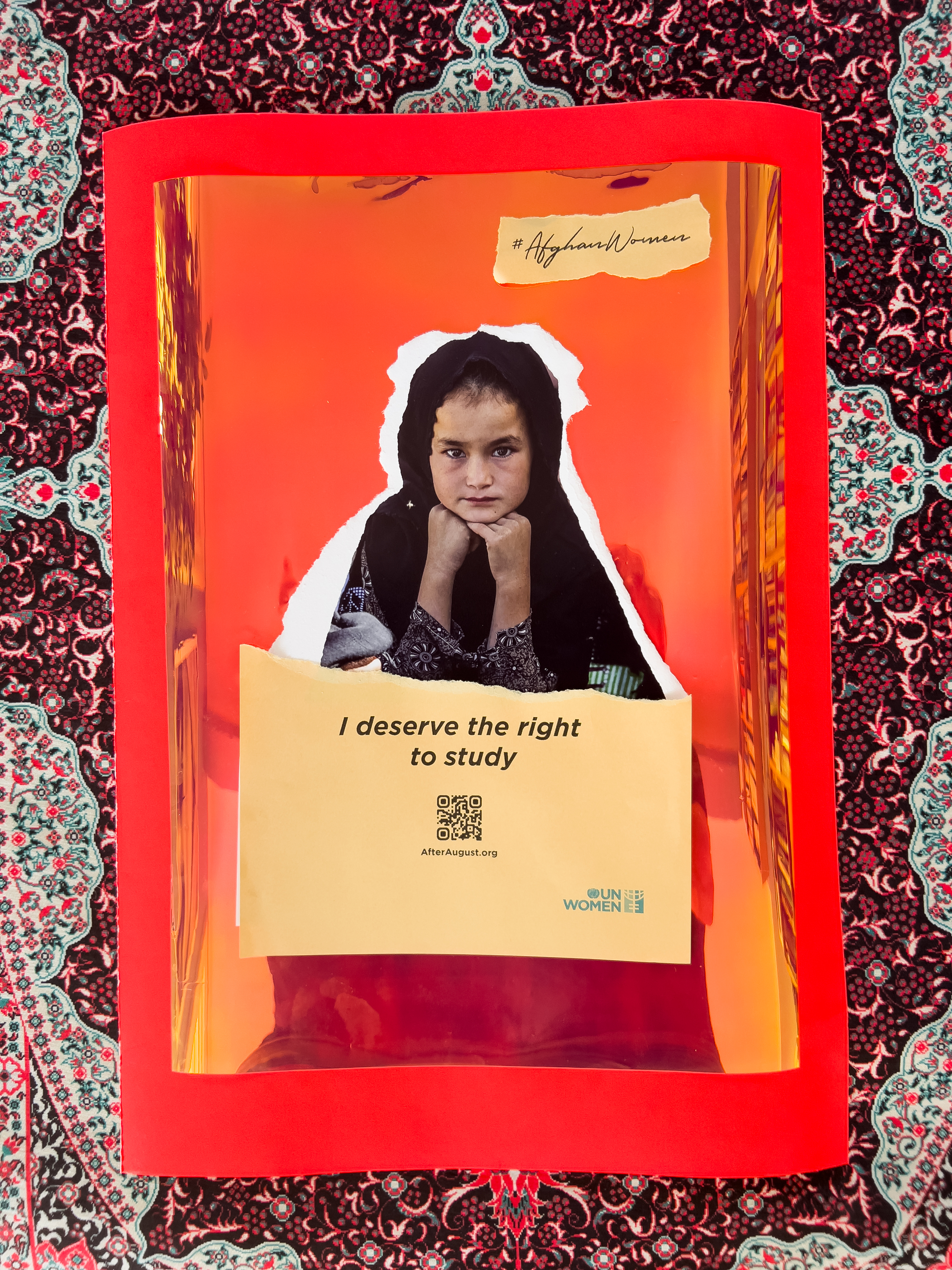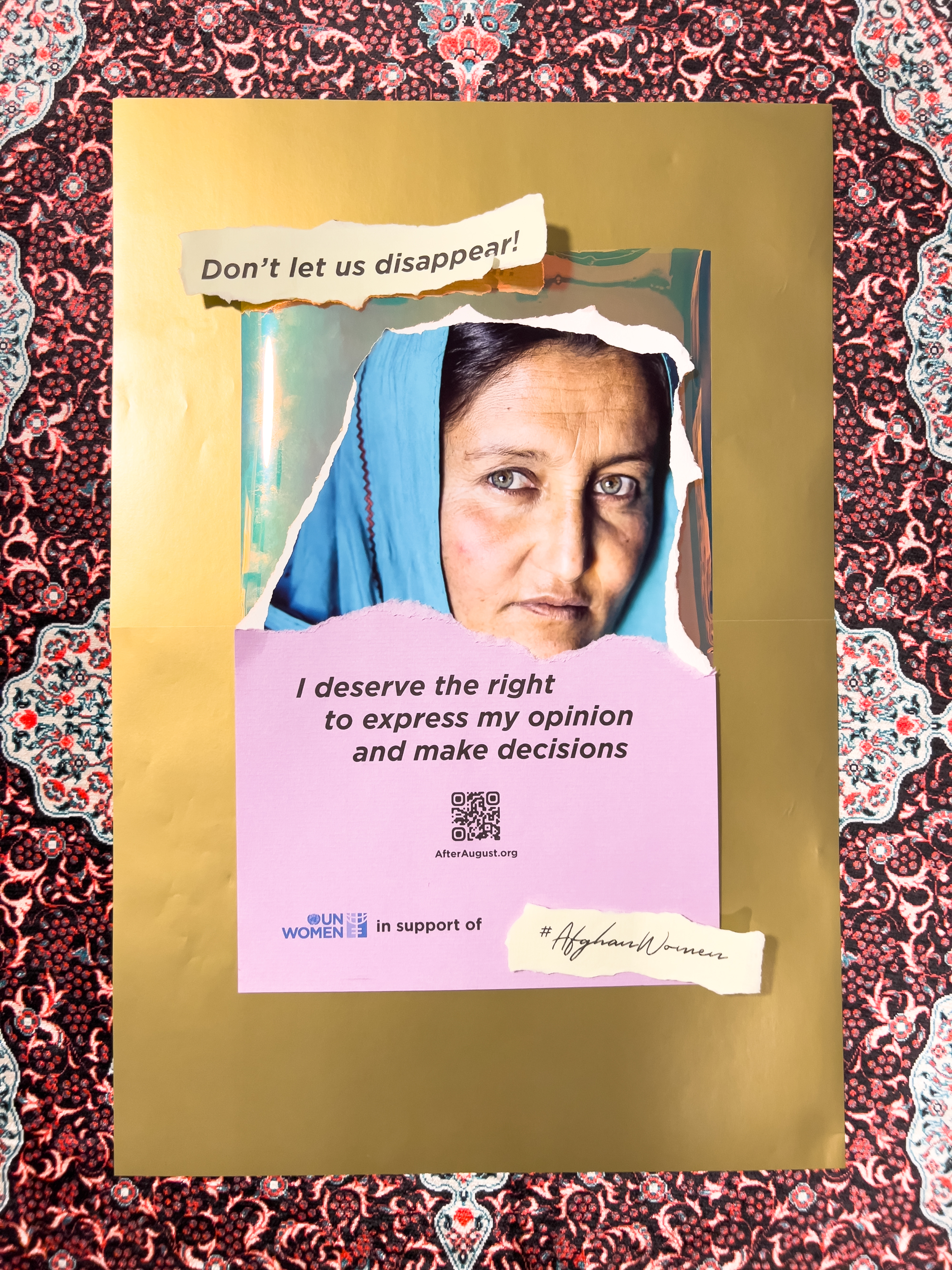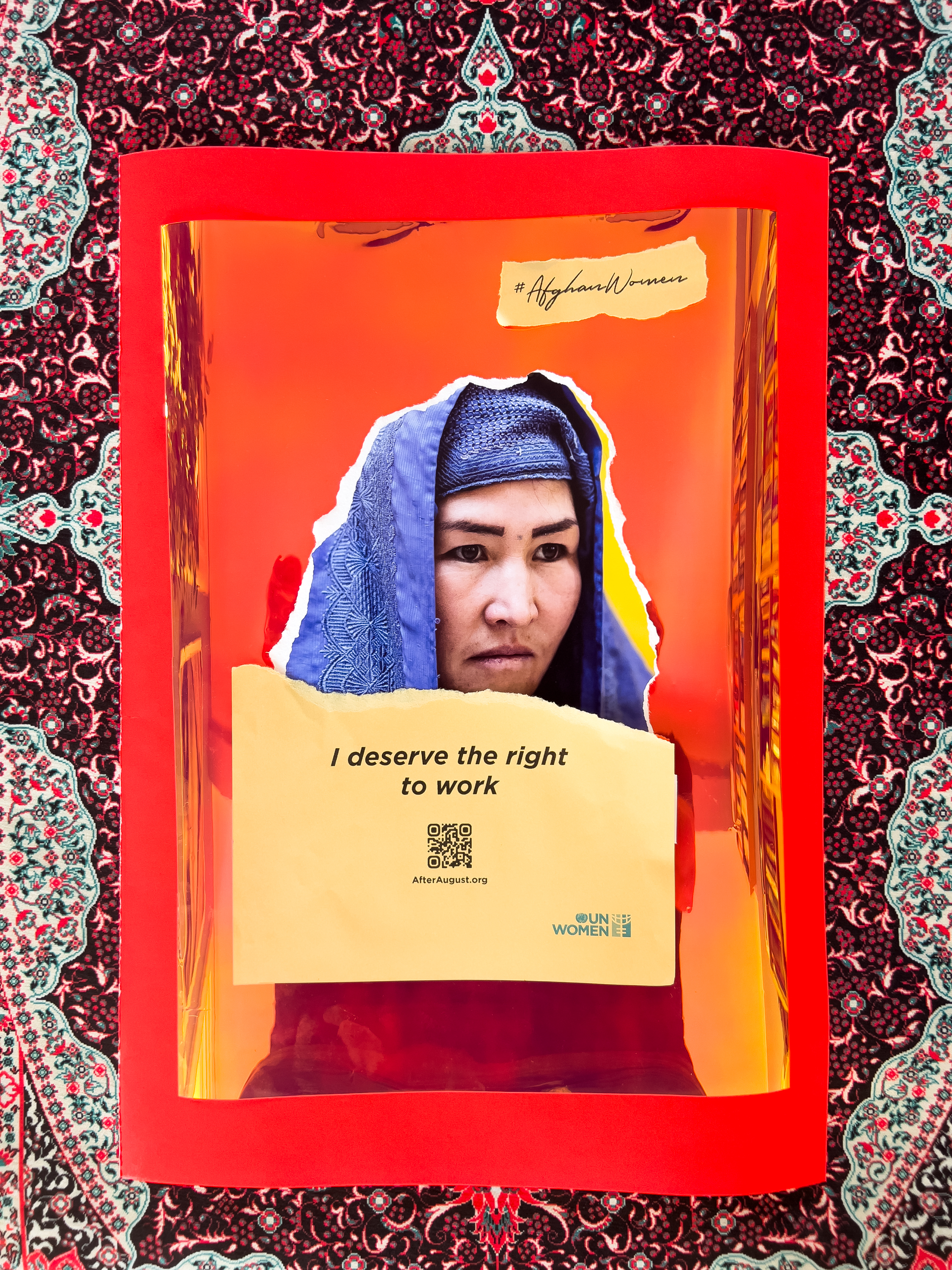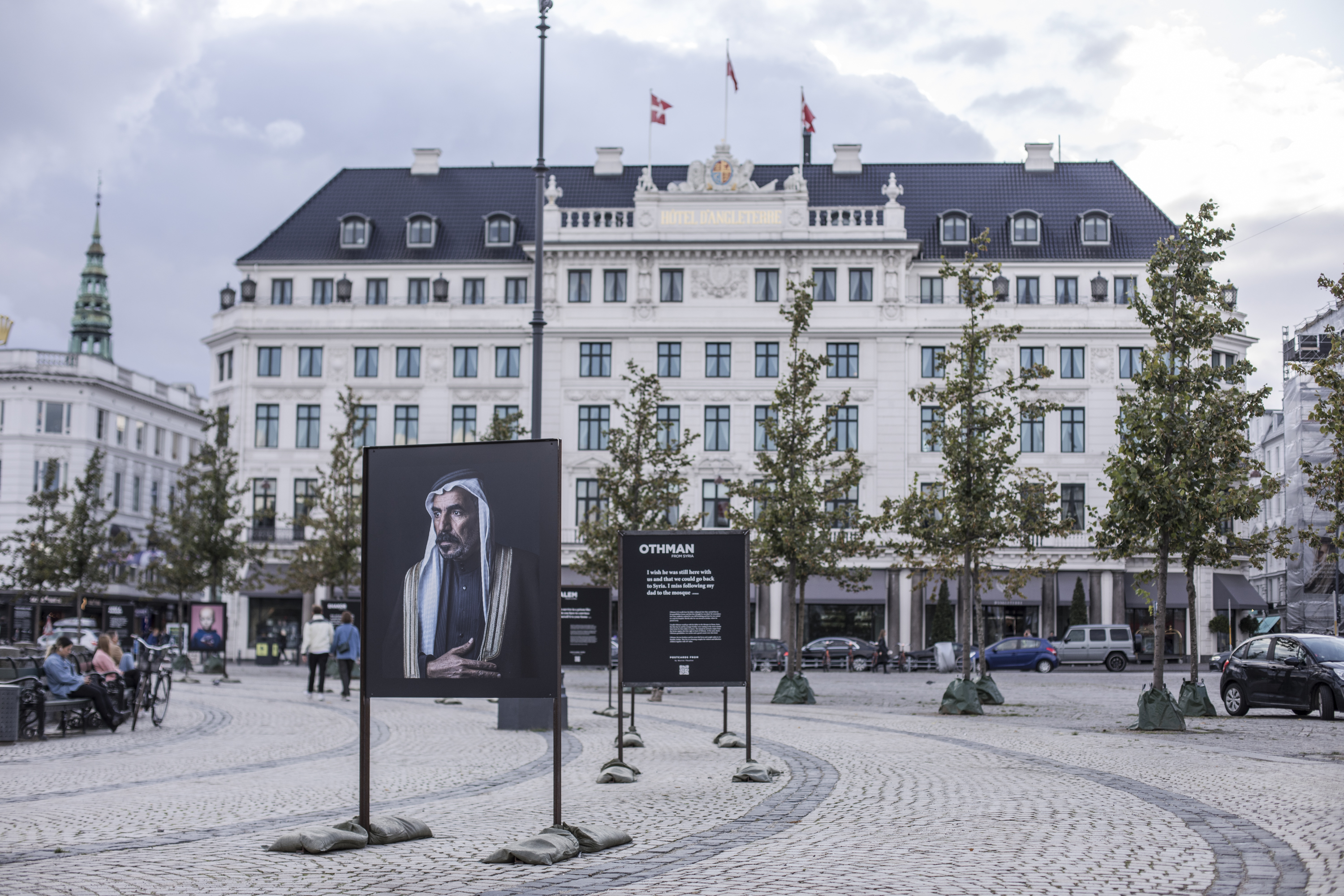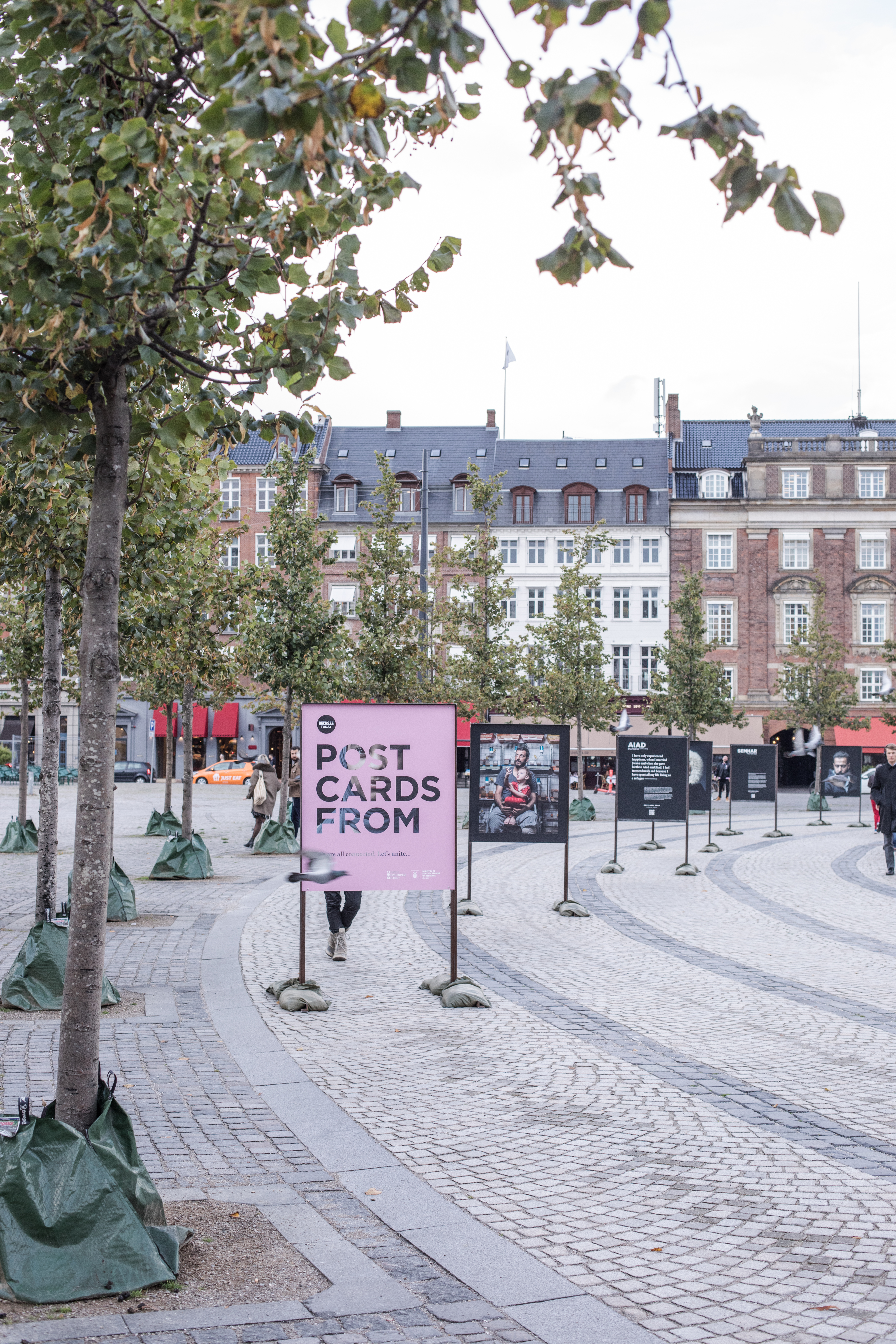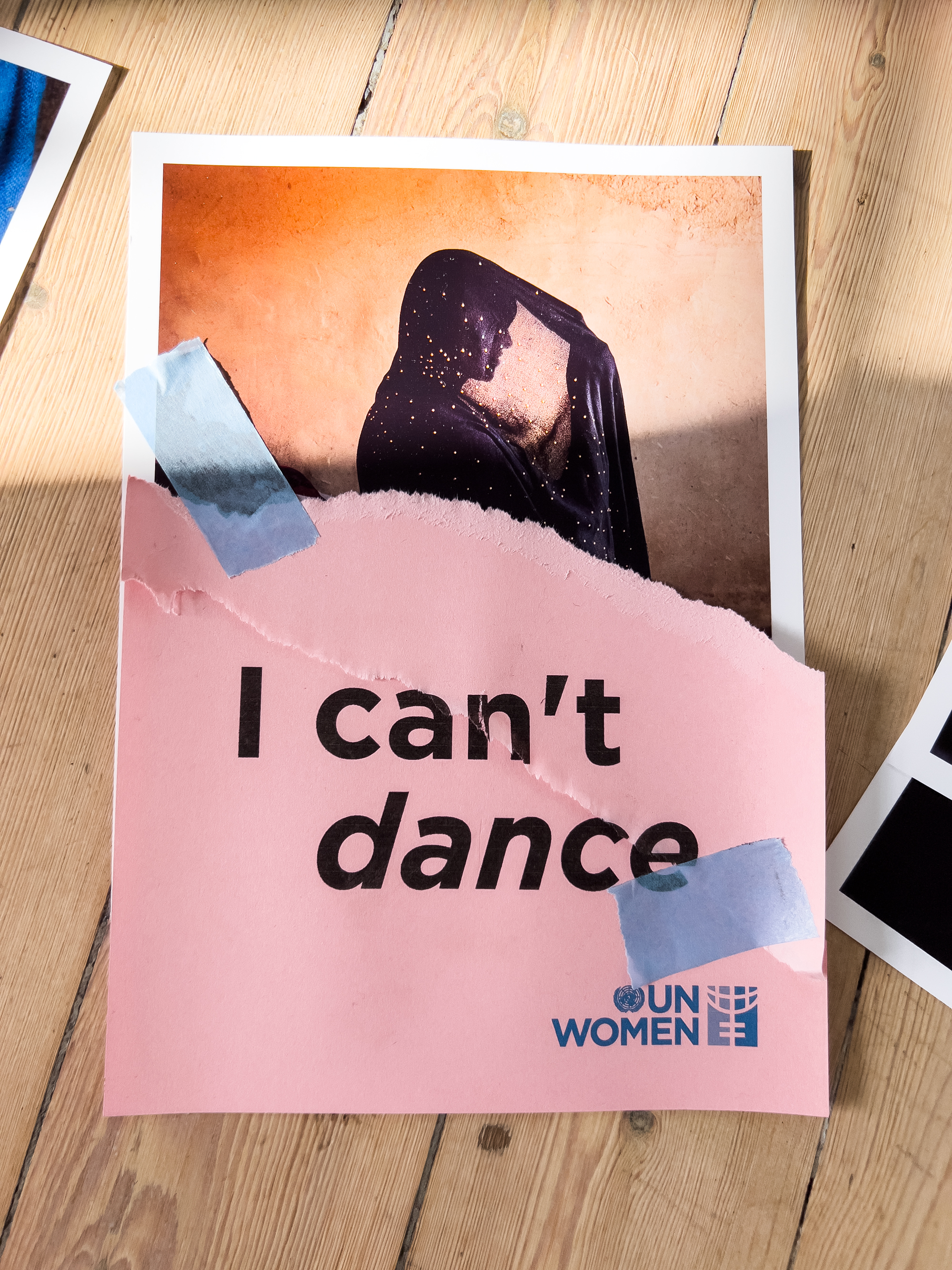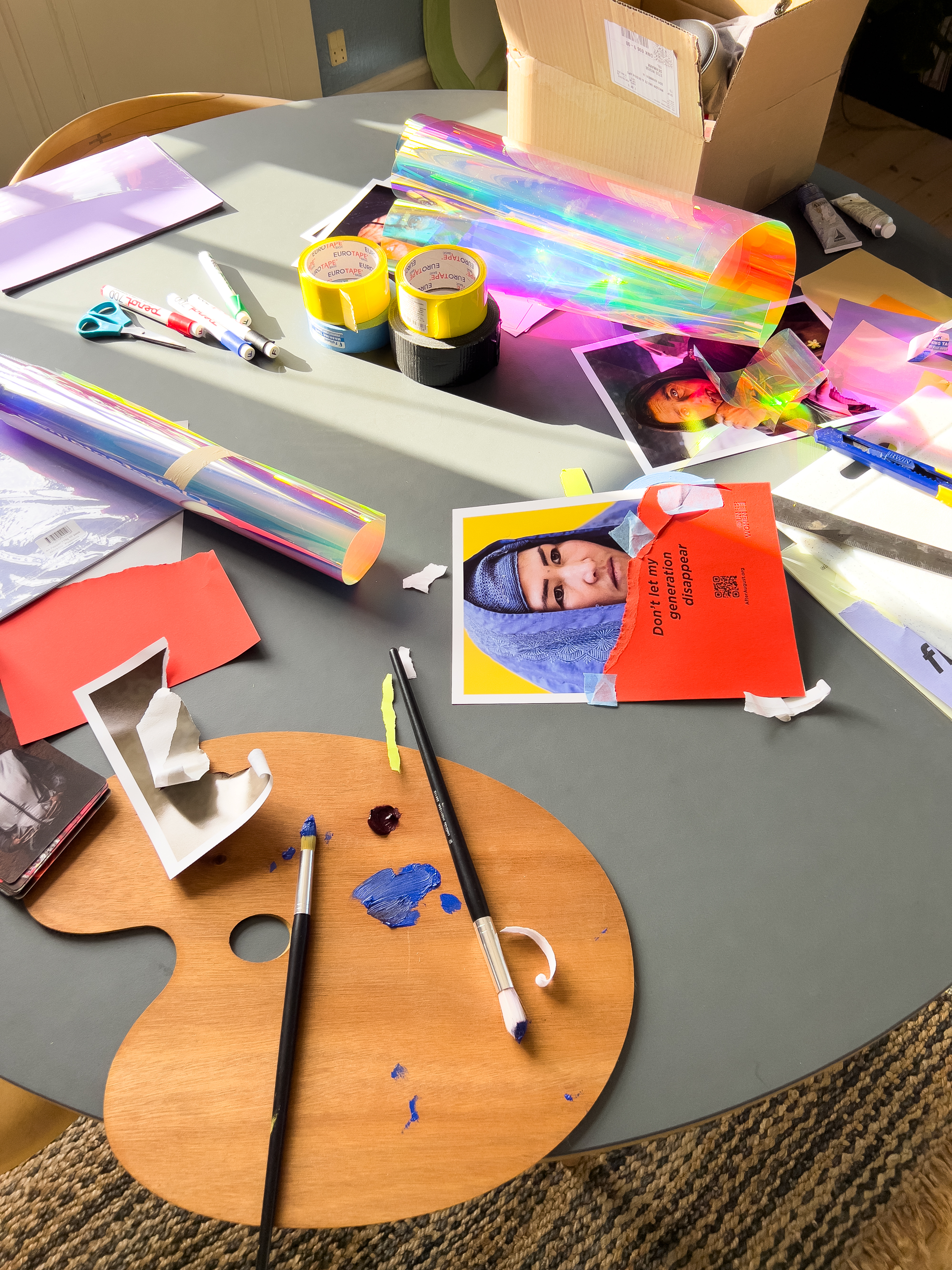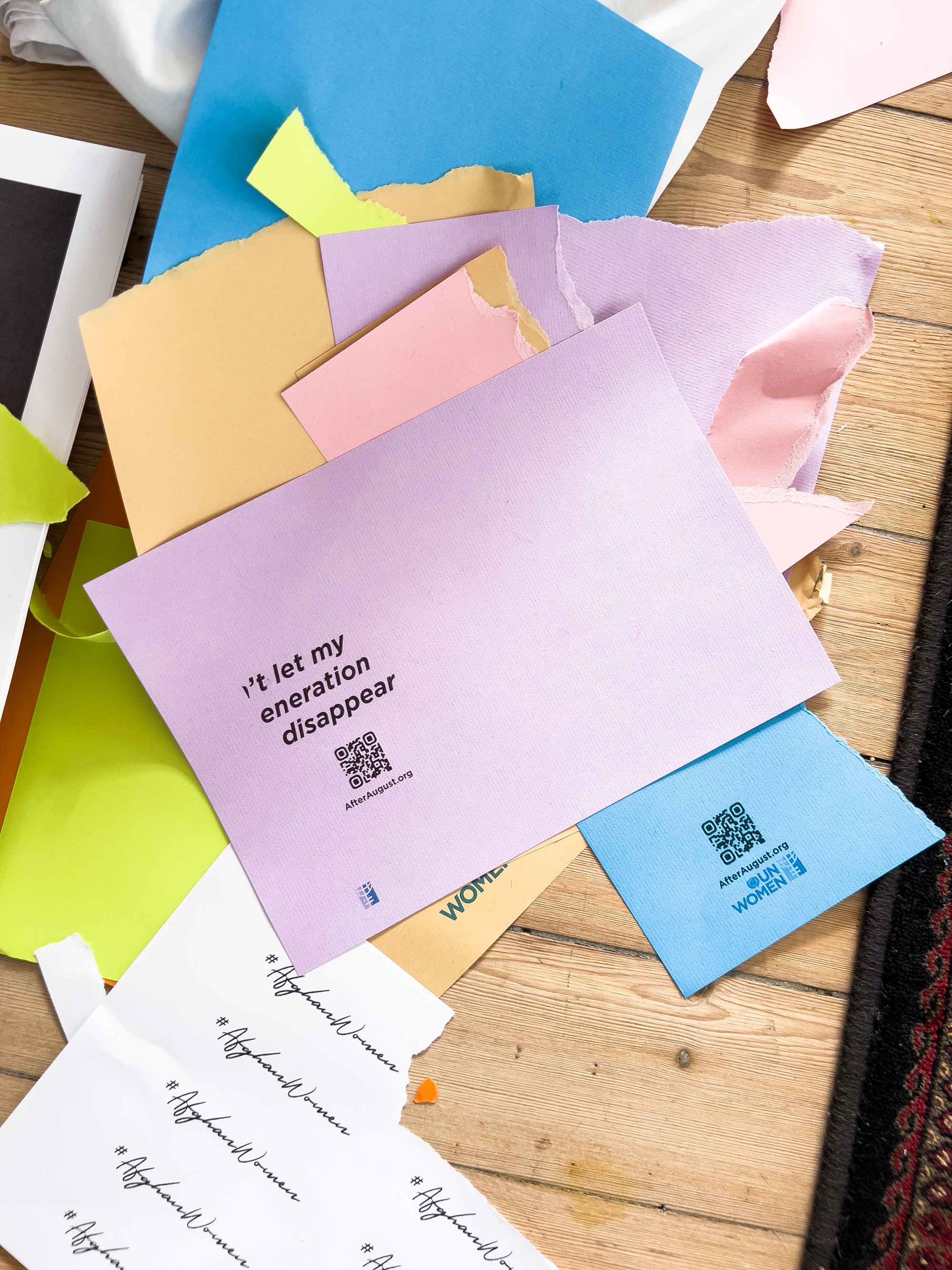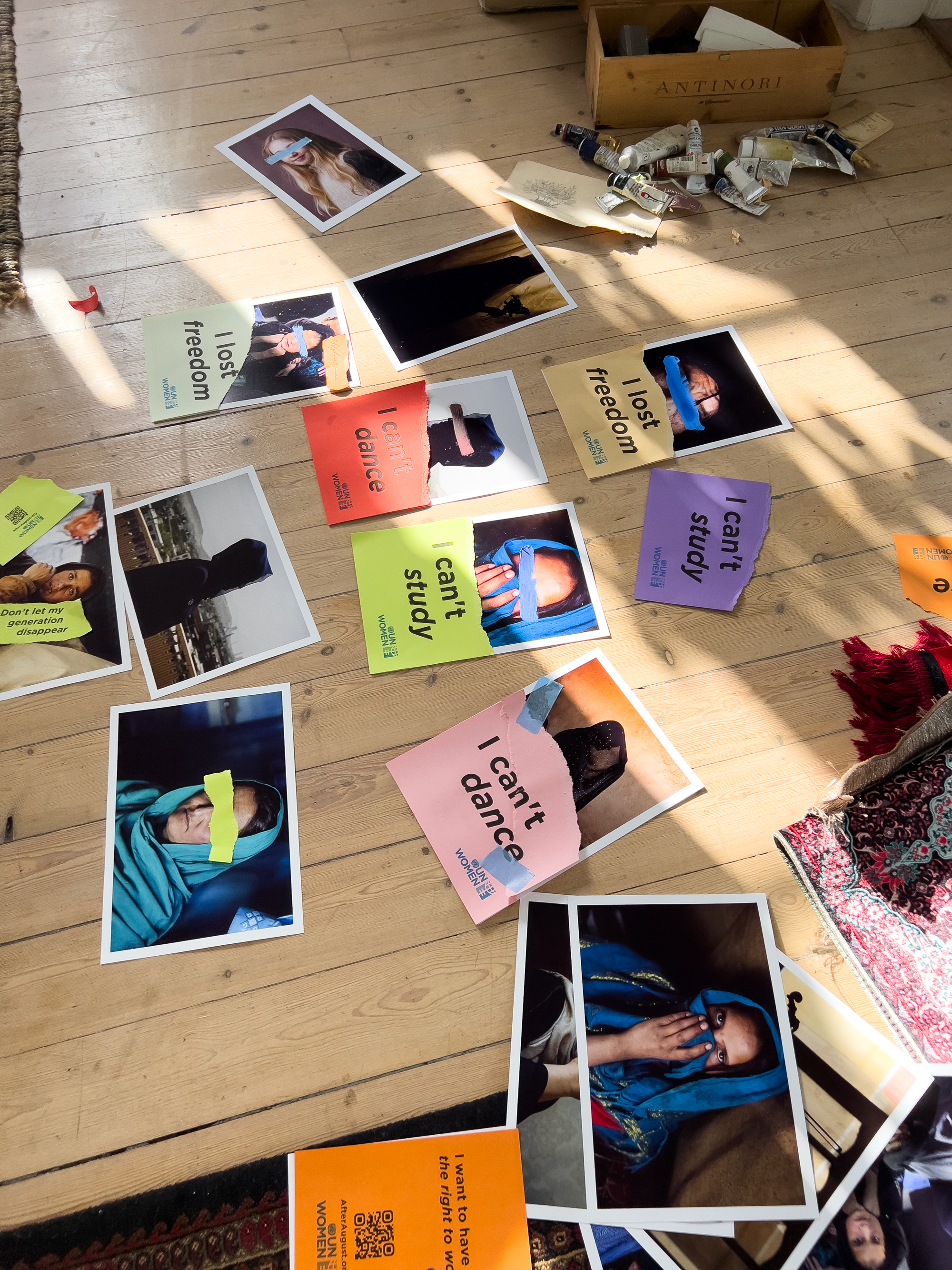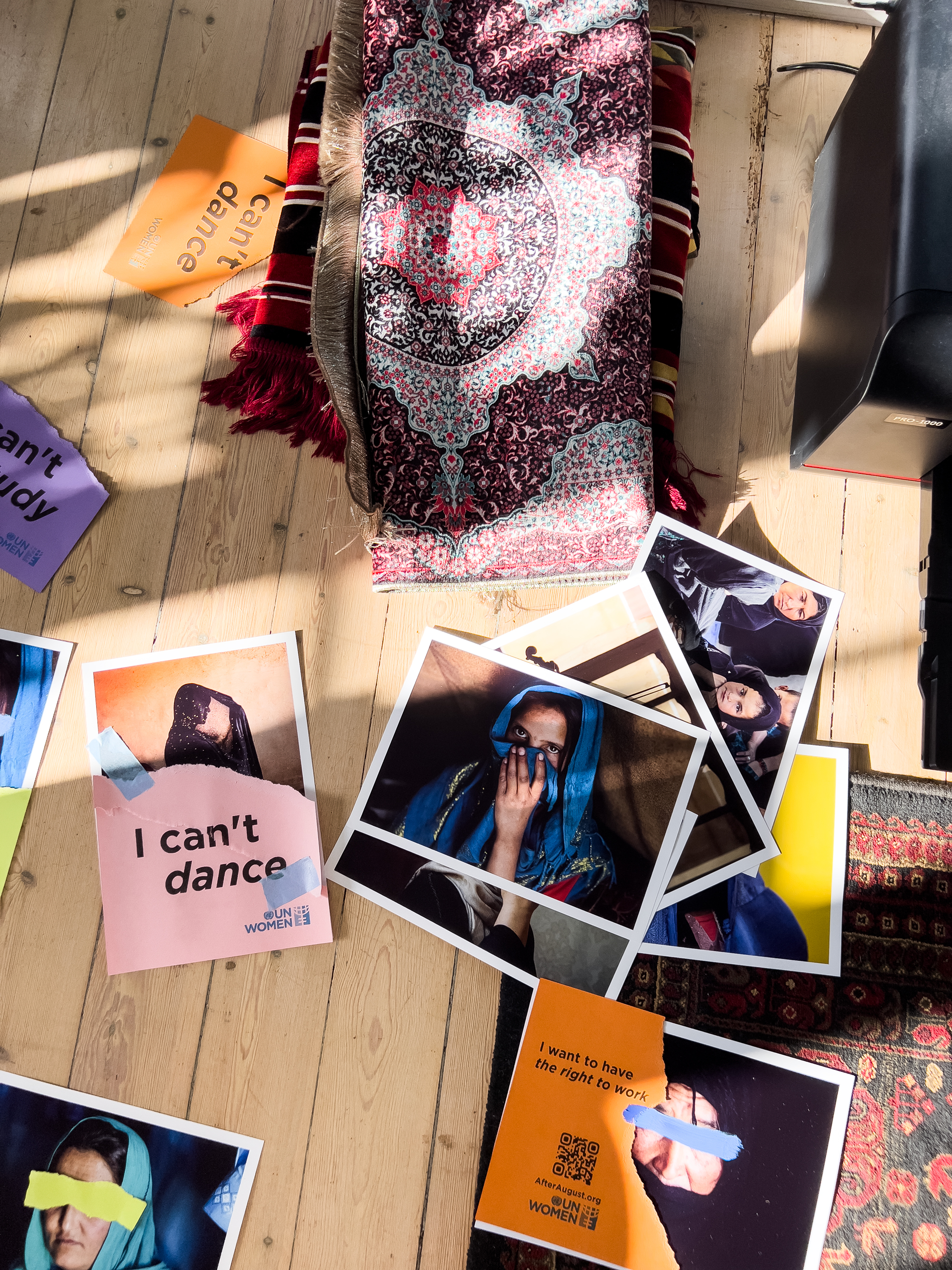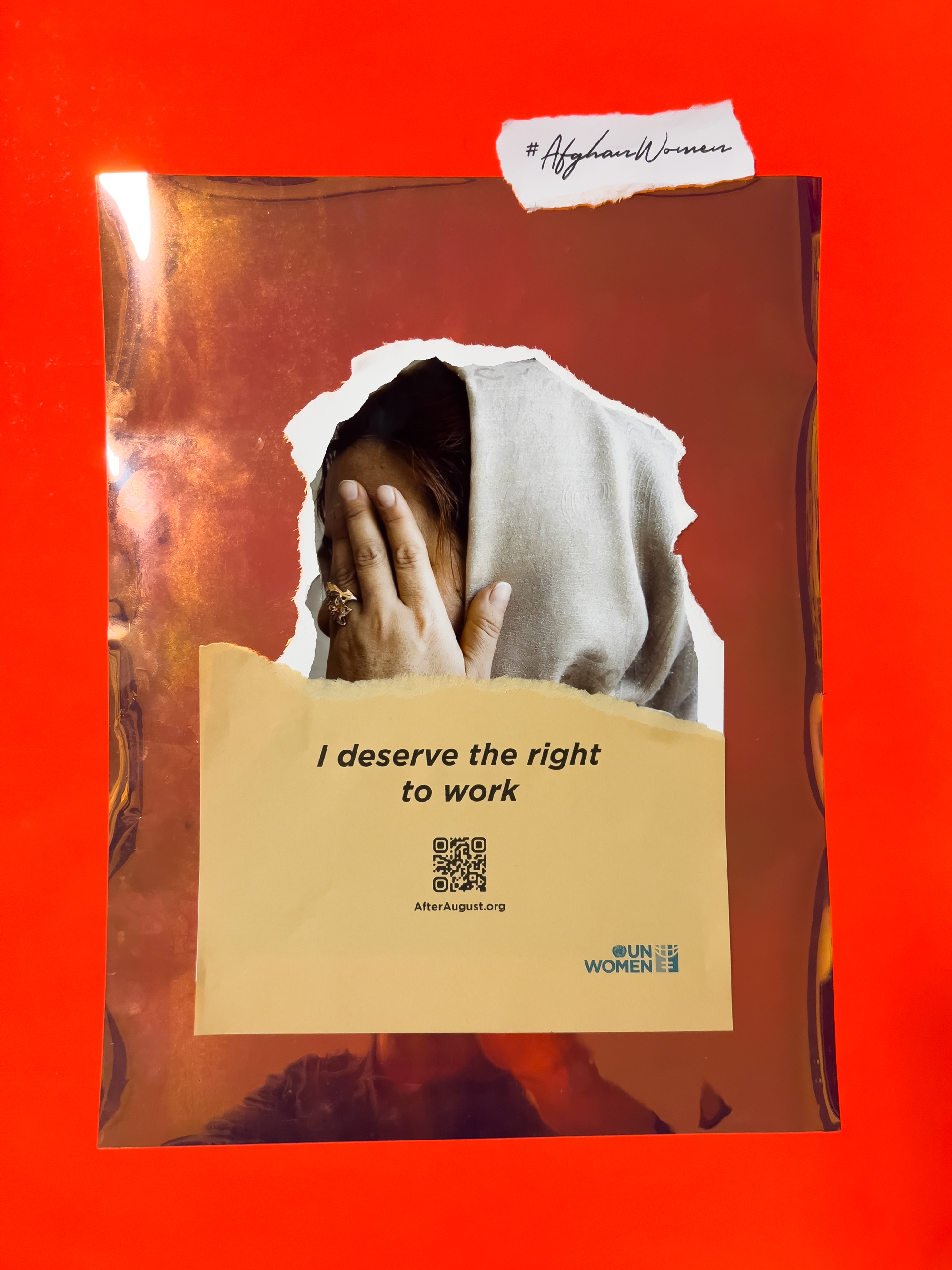Dear Olga, Elle & UN Women team
Please find our proposal below
A campaign concept by Good people for UN Women Afghanistan
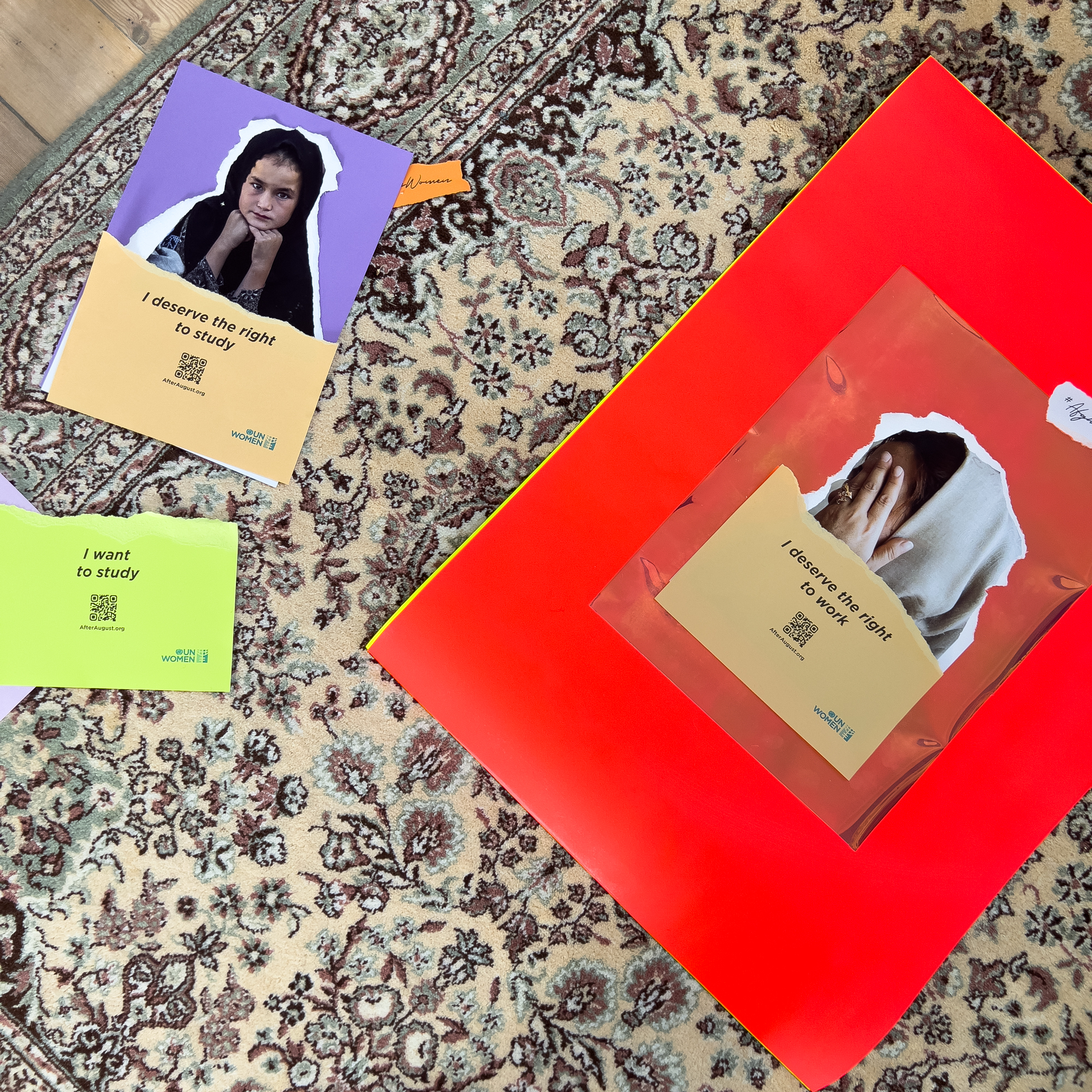
in Support of Afghan Women
Don't let us disappear!
Introduction
Two years in the wake of the international withdrawal from Afghanistan and into the consequent and increasingly abject assault on the rights of women and girls there, the world’s attention is turning to other crises and long-term crisis apathy settles in. To bring back the plight of the Afghan women and girls to the collective consciousness and call for support, a multidisciplinary team under Good people (get to know the team behind) proposes a wide, multi-city appeal to the international community, framed under the banner: Don’t let us disappear! As the Afghan women and girls’ struggle is our collective struggle, we need our collective voices to amplify theirs. At the end of the day, we are all Afghan women. This message encompasses the idea that ‘just because it is not happening here it does not mean it should not matter,’ while at the same time embodying a most direct call for collective action, particularly from environments with potential for policy influence.
Campaign concept
Samples of installations in public space.
The campaign is conceptualised as a multi-city public space exhibit: a two-to-four-week display of approximately 20 photographic artworks of 1.05 x 1.26 meters in public spaces in multiple cities, including: Berlin, Brussels, Copenhagen, Geneva, London, New York and Paris. Learn about the visual concept.
The artworks will be based on the photographs and stories from the AfterAugust.org campaign, selected based on their highest potential for eliciting solidarity. At a crossroad between art and documentary, using art as a means of promoting accountability and drawing attention to the plight of Afghan women holds great potential. Messaging will be adapted and streamlined to create simple but catchy, compelling and thus impactful public engagement. Large in format and displayed in central public areas with high public traffic, the exhibits will draw in sizeable crowds, involving and communicating with an audience that are not necessarily museum visitors. Exhibiting in public spaces also adds an element of disruption, with the potential to enhance impact. Via QR codes, offline engagement will be used to drive traffic to the existing stories on AfterAugust.org, encouraging people to engage with the site and learn more about the situation of women and girls in Afghanistan. The content produced under the Don’t let us disappear! campaign will be suitable for online presence and will include hashtags to drive social media engagement, too.
Samples of installations in public space.
-
Read more
Wherever possible, Good people will aim to involve in the campaign Afghan refugees residing in these cities, particularly women and girls of work age, schooling activities permitting (e.g., joining the exhibits to provide additional, detailed information about the situation in Afghanistan and the plight of the women and girls there, including, as they wish, personal stories). Direct, personal interaction facilitates more empathetic engagement, enhances the opportunities for media presence and, not least, deepens ownership by the Afghan community.
The seven cities have been selected for the potential for impact: they are affluent as well as commercial, media and policy hubs, with a particular focus on potential for policy impact on the situation of women and human rights in Afghanistan. These cities also present significant opportunities for media engagement, which beyond its intrinsic importance, would generate further traction to the AfterAugust.org platform. These cities also present the opportunity of linking with creative communities and – particularly relevant, international human rights and humanitarian – NGOs, which could more easily be thus engaged to further amplify the campaign’s outreach. As Good people is based in Denmark, which also boasts a UN City, Copenhagen was also included among the selected cities.
The appeal will be boosted by a media campaign, including social media, adding yet another leverage of inter-connected reinforcement. Particularly in the media campaign, this appeal could be juxtaposed with the celebration of the 75th anniversary of the UDHR – this very juxtaposition bringing to starker light the return to the 1990s conditions for Afghan women and girls and thus strengthening the appeal’s impact.
Cross collaborations and public exposure
Subject to calendar constraints and agreements with artists, the campaign will strive to co-opt visuals from prominent Afghan artists (e.g., Negina Azimi, Mursal Ahmadzai, Shamsia Hassani, Fatimah Hossaini, Kubra Khademi, Sara Rahmani, Rokhsar Rahmini, Malina Suliman but also Omaid Sharifi etc.) to boost messaging (e.g., Fatimah Hossaini’s emblematic split photograph from the Modern Bondage series). The artists’ influential roles in advocacy would thus be reinforced while they themselves would be supported through public recognition. This part of the campaign will be executed in full partnership with the artists.
Both visuals and messaging will be unified through a coherent theme throughout the exhibits, combining: a) exposure to the situation in Afghanistan, as documented in the UN Women reports and the AfterAugust.org women’s own stories; b) expression of resilience and hope, drawn from the AfterAugust.org women’s own stories and engagement by prominent Afghan artists/advocates; and c) impactful appeals for support for women and girls’ rights in Afghanistan. UN Women’s logo and the subtitle ‘UN Women in support of #AfghanWomen will feature throughout the campaign. Digitised, the artworks could become social media cards to further amplify the campaign and extend its life.
-
Read more
To further opportunities for exposure, including through social/media, the campaign could be supplemented by public transportation advertisement, also in multiple cities. This would amplify and bring the campaign to wider segments of the general public. Depending on timeline and/or funding constraints, this could be limited to a few cities with significant multilateral presence (first priority Brussels and NY; second priority Copenhagen and Geneva), where ads on public transport lines passing by, for instance, the UN headquarters in NY and key EU institutions in Brussels, could also provide additional media opportunities. Subject to social/media impact results, the public transportation ad campaign could be expanded to multiple cities across the global North and South.
Depending on feedback from this campaign and funding availability, the appeal could be expanded further, to additional cities, and supplemented – under the same coherent theme – by:
Exhibiting existing or newly commissioned artwork by Afghan artists in public spaces, to complement the initial exhibits. Collaborations with local authorities will be pursued.
Creating an interactive and/or animated timeline based on the timeline in the UN Women reports (e.g., animating the reversal of rights, back to the 1990s).
A poster and/or postcard campaign feature, based on the campaign’s artwork, with the potential option of commercialising these through National Committees for UN Women.
At the same time, a long-term digital campaign could be created building on the AfterAugust.org platform. Supported and boosted through the public space exhibits, this could become an interactive, user-friendly reference hub for the advocacy campaign in support of Afghan women and girls, bringing together information, educational material and advocacy tools for comprehensive use that is also tailored to a variety of user needs. For this reason, introducing fact boxes highlighting key findings from reports as well as direct links to these reports could also be considered. Lastly, AfterAugust.org could also link with the existing platforms, campaigns and tools, such as, empowerwomen; the interactive timeline Women of the world, unite!; HeforShe etc.
The concept exemplified below, including messaging, is indicative of the final creative outcome, to be further refined subject to discussions and agreements with UN Women Afghanistan.
Methodology
The final campaign images are created by hand through an artistic process. The digital images already present on AfterAugust are printed, manually modified (torn by hand) and incorporated into a collage along with the following elements: a hashtag (#AfghanWomen); a statement from an existing story or a key finding from a report; the UN Women logo; a QR code (linked to AfterAugust.org); and the website address. The idea is to consistently incorporate Afghan carpet patterning/ornamentation as the final layer to frame the artwork. Our objective is to produce highly artistic and iconic pieces that capture attention and encourage engagement. These iconic artworks can be reproduced through a printing process, allowing the exhibition plates to resemble collage artworks on display. We have developed a method to print these artworks in 4-5 steps to replicate the look and feel of the collages created in the process mentioned above.
Team Good people
The campaign is conceptualised by the Good people team in an interdisciplary partnership that brings together art, activism, strategic vision and direct Afghanistan experience among:
-
Martin Thaulow
Martin Thaulow, founder and Director, Good people, providing creative conceptualisation and management as well as direct artistic input. Martin Thaulow is a member of the Danish Union of Journalists, commissioned and working as a photojournalist for news media, magazines, NGOs and organisations such as Amnesty International, the Danish Refugee Council and the Red Cross, UN (UNICEF, UNESCO), among others. Since 2014, Martin Thaulow has been portraying and documenting the life of victims of oppression, including torture, and refugees as one of his main priorities, working in countries such as Bulgaria, Denmark, Estonia, Germany, France, Finland, Germany, Greece, Iraq, Italy, Jordan, Latvia, Lebanon, the Netherlands, Poland, Rwanda, Spain, Sweden, Türkye and Ukraine, where during the past four years he has had more than 50 installations of photo exhibitions in public spaces, galleries and museums Originally, he was trained as a fine arts painter, but later expanded his work into photography, video art and multimedia installations. He is a keen collaborator with artists from a wide range of disciplines.
-
Catinca Slavu
Catinca Slavu, providing strategic input related to the conceptualisation, management and implementation of the initiative. Catinca Slavu is a governance and democracy-strengthening expert with a focus on constitutional, political and peace processes. She has advised civil society, governments as well as state and multilateral institutions in post-conflict, transitional and fragile contexts in the Balkans, the Caucasus, South-East Asia and the Middle East-North Africa region as well as in Africa and Latin America. She has designed, run and evaluated large-scale EU, OSCE and UN programs for participatory processes and civil society engagement. From policy development to strategic leadership, she has focused on inclusion and participation as prerequisites for democratic transformation and sustainable stability. Catinca Slavu has direct experience from Afghanistan, where she worked and lived in 2004 as well as 2008-2010.
-
Ivan M. Nielsen
Ivan M. Nielsen, providing strategic, contextualisation and human rights input. Until he left the Danish diplomatic service in 2021, Ivan M. Nielsen served as Denmark’s Representative for the Syria Crisis for over eight years. He brings leadership in human rights, conflict management and peace and constitution-making processes. As a human rights adviser to South Africa’s Constitutional Assembly, he was instrumental in conceptualising a value-based constitutional process. With the Danish Institute for Human Rights and the UN, he continued to provide value-based strategic planning and organisational development to human rights institutions across Africa, Asia and Latin America. His diplomatic focus before Syria was on state fragility and the nexus between foreign and security policy, including in senior positions in Afghanistan, where he was the longest serving senior Danish diplomat, first serving as Denmark’s Deputy Ambassador in 2008-2010, in Kabul, and later as Senior Civilian Representative in 2011-2012 in Helmand.

